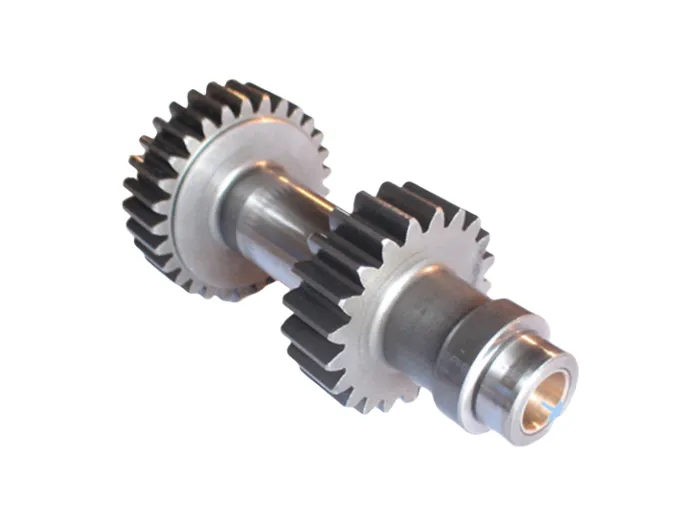Structural Characteristics
Gear tooth structure: there are a variety of tooth shapes, such as involute tooth shape, smooth transmission, high bearing capacity; Cycloidal tooth shape, high transmission efficiency, low wear. Parameters such as modulus, number of teeth and pressure Angle of the gear teeth are designed according to different transmission needs. The modulus determines the size and carrying capacity of the gear teeth, the number of teeth affects the transmission ratio, and the pressure Angle affects the transmission power and stability.
Hub and shaft hole: hub is the part that connects the gear teeth and shaft to provide support and positioning for the gear, the shaft hole is used to match with the drive shaft, may have a keyway, spline and other structures, so that the gear and shaft are reliably connected to transmit torque.
Other structures: Some power output gears may be provided with an annular oil groove and an oblique oil hole leading to a central through hole on the end face to improve lubrication and reduce wear.
Working Principle
Transmission based on mesh: The power output gear meshes with other gears and transmits power by mutual contact and friction between tooth profiles. The teeth of the driving gear push the teeth of the driven gear, so that the driven gear rotates, and the power is transferred from the drive shaft to the driven shaft.
To achieve movement and force conversion: by changing the tooth ratio of the gear, you can change the speed and torque size, to achieve deceleration or growth transmission. When decelerating, the torque increases and the speed decreases; When increasing, the torque decreases and the speed increases to meet the needs of different working parts.
Application Scenario
In the field of industrial machinery: in the feed system and main shaft transmission system of various machine tools, the power output gear transmits the power of the motor to the workbench, tools and other components to achieve accurate motion control; In the crane, conveyor and other equipment, it provides power for the lifting mechanism and the conveying mechanism to ensure the lifting and transportation of materials.
Automotive field: In the transmission of automobiles, the power output gear transmits the power of the engine to the drive shaft with a suitable transmission ratio according to different driving conditions, and then to the wheels; In the transfer box of the car, the power output gear distributes the power to the different drive axles to achieve the four-wheel drive or multi-drive function of the vehicle.
Aerospace field: In the engine transmission system of aircraft, the power output gear transmits part of the power of the engine to the generator, hydraulic pump and other auxiliary equipment; In the landing gear retracting mechanism of an aircraft, power is provided for retracting and lowering the landing gear.

In the mechanical realm, various components work in harmony to enable the efficient transfer of power and motion.

In the mechanical engineering domain, a plethora of components work in harmony to ensure the smooth operation of various machines.

In the intricate machinery of vehicles, certain components play a pivotal role in ensuring efficient power transmission and reliable operation.

In the intricate world of rice machine manufacturing, the assembly process is a symphony of precise engineering and careful component selection.

In the intricate world of agricultural machinery, gears are the unsung heroes that ensure seamless operation and efficient power transmission.

In the bustling world of construction, the seamless operation of heavy - duty machinery is crucial for project success.

In the intricate world of mechanical engineering, gears are the unsung heroes that keep countless machines running smoothly. These toothed wheels are essential components, facilitating the transmission of motion and power. From the robust drive gears that initiate movement to the specialized corn machine gear and returning machine gear designed for specific agricultural equipment, and the complex gearbox assembly that houses multiple gears, as well as the highly precise high precision gear used in demanding applications, each type plays a vital part in different machinery systems.

Mechanical systems, whether in industrial machinery or agricultural equipment, rely on a variety of components to function effectively. Among these essential parts, gears play a pivotal role in transmitting power and motion. From the gearbox gear that forms the core of power transmission within a gearbox to the drive gear that initiates the movement of a system, and the specialized bevel gears that change the direction of motion, gears are integral. In the agricultural sector, components like wheat machine gear and deep tiller gear are vital for the proper functioning of farming equipment, ensuring efficient crop processing and soil cultivation.

In the intricate world of mechanical engineering, certain components play a crucial role in ensuring the smooth operation of machinery, especially in the agricultural sector. From the gears that transfer power to the seats that facilitate meshing, each part contributes to the overall functionality and efficiency. Arc gear, meshing seat, harvester gear shaft, corn gear, and returning gear are among the key elements that are integral to various mechanical systems, particularly those found in agricultural equipment.

In the intricate world of mechanical engineering, a variety of specialized components work in harmony to ensure the smooth operation of machinery. From agricultural equipment to industrial gear systems, components like border inspection assembly, ring gear/gear ring, high frequency gear, meshing seat, and harvester input shaft play crucial and distinct roles. Each of these elements is designed with specific functions in mind, contributing to the overall performance, durability, and efficiency of the machinery they are part of.

Power Output Gear: Efficiency, Strength, Unmatched Performance!
Maximize machinery output with durable, high-precision power output gears for optimal results!
International layout
Spread all over the world
our products are exported to various parts of the world. Currently, our products have been exported to more than 40 countries Our products cover Asia, Europe, Africa, South America, North America, and Oceania
Sign up
for Newsletter
Subscribe to the weekly newsletter for all the latest updates






